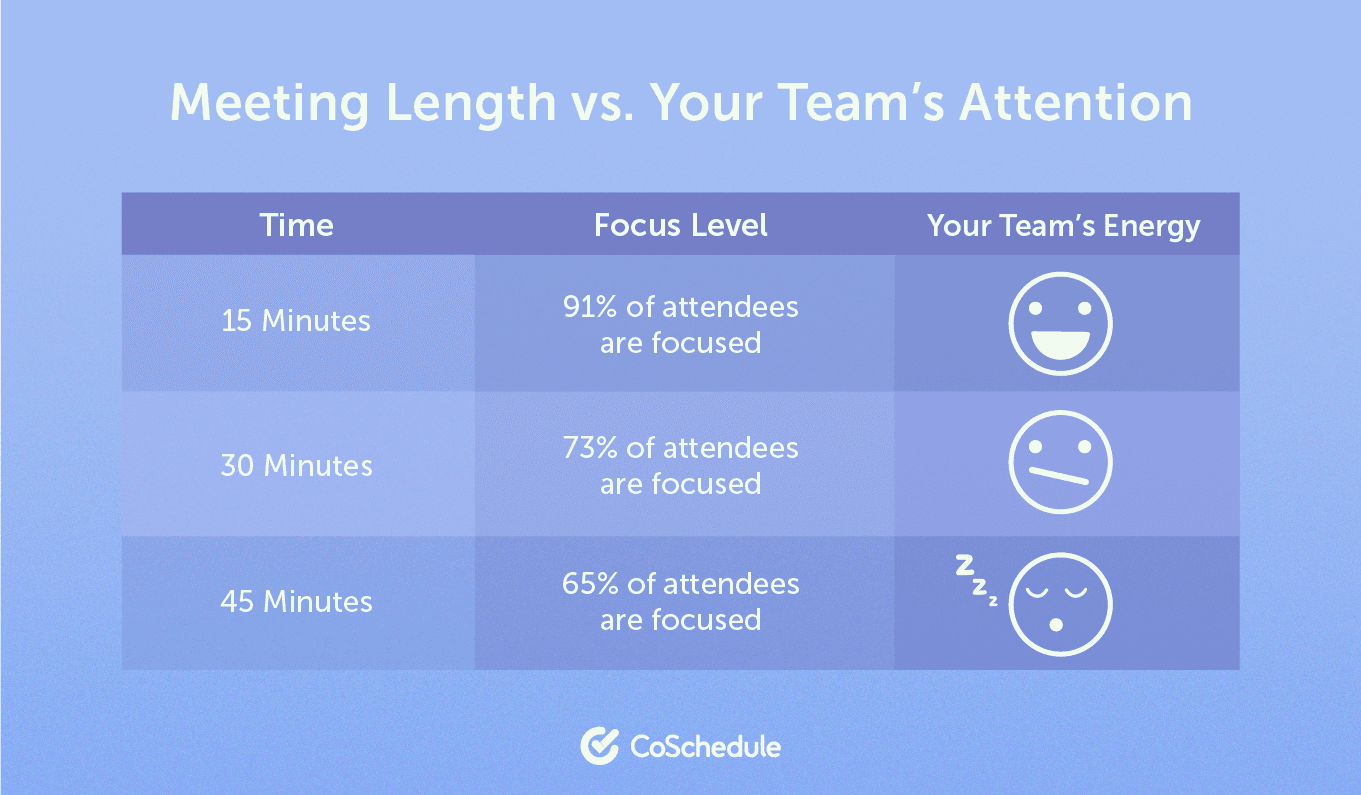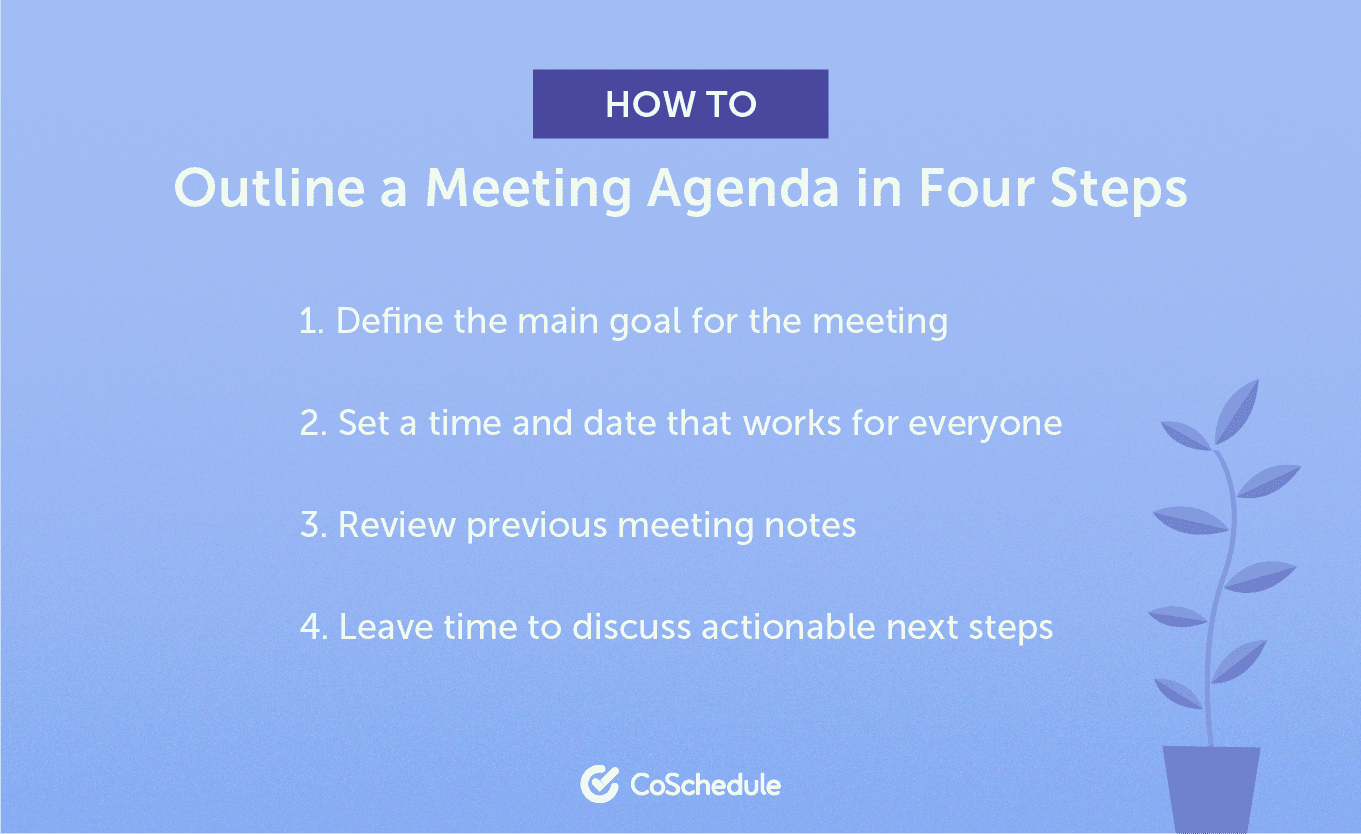Marketing Meeting Agendas: How to Make Your Meetings 10x More Productive (Template)
 You’ve sat in a meeting for two hours. By the end of it, you’re left with one overwhelming (and frustrating) thought:
“That meeting could’ve been an email.”
It’s a surprisingly common thought — a frustrating one, nonetheless.
Luckily, there is an easier way to make sure you’re only meeting for things that actually need to be discussed in a group. The best part? It’ll help you whittle down the number of people in attendance.
It lies within a marketing meeting agenda.
In this guide, we’ll share a free marketing meeting agenda template that will help you host your most productive (and least boring) meeting.
You’ve sat in a meeting for two hours. By the end of it, you’re left with one overwhelming (and frustrating) thought:
“That meeting could’ve been an email.”
It’s a surprisingly common thought — a frustrating one, nonetheless.
Luckily, there is an easier way to make sure you’re only meeting for things that actually need to be discussed in a group. The best part? It’ll help you whittle down the number of people in attendance.
It lies within a marketing meeting agenda.
In this guide, we’ll share a free marketing meeting agenda template that will help you host your most productive (and least boring) meeting.
Marketing Meeting Agendas: How to Make Your Meetings 10x More Productive (Template)
Click To TweetEveryone Hates Meetings — Here’s Why
The general consensus is that meetings are a waste of time. Here’s why we think that.They Take Too Long
Meetings are designed to talk about things in-depth that are more complex than an email or Slack thread. In the first 15 minutes of your meeting, 91% of attendees are focused. This drops to 73% between the half-hour and three-quarters of an hour, falling even further to 65% after the 45-minute mark. Meetings tend to creep up to the hour-long mark — even if that’s not the intention, at first.
You have so many things to talk about, and conversations from the original point can quickly spiral out of control.
Meetings tend to creep up to the hour-long mark — even if that’s not the intention, at first.
You have so many things to talk about, and conversations from the original point can quickly spiral out of control.
They Veer Off-topic
If meetings are spread once a week, staff might use them as your chance to raise specific things, hence why meetings can turn into an hour-long discussion. Your staff might use the meeting opportunity to:- Ask for permission to buy a new tool
- Explain your new process for signing off things
- Plan around upcoming staff absences
They Include People Who Don’t Need to Be There
You’re planning a new email campaign, and your social media team is invited just in case they have any special input. They don’t really need to be there; they’re just hedging their bets on the off-chance there’s something mentioned that’s valuable to them. This is common practice for most meetings. The room starts to become overcrowded with people who are attending and don’t actually need to be there. Not only does it waste their time, but it over-crowds the meeting room with too many opinions.What Can Make Marketing Meetings Effective?
Meetings can be boring and unproductive, but they’re still important.Meetings can be boring and unproductive, but they’re still important.
Click To TweetThey Help Everyone on a Project Get on the Same Page
Do you constantly have people feeling frustrated because they missed something important? It can be frustrating for everyone involved — especially if the issue causes you to miss a deadline. However, getting everyone in the same room for a meeting or on the same video call (if you’re remote) stops people from getting left behind.They Give Everyone an Opportunity to be Heard
We know that meetings can quickly become overcrowded when too many people attend. It’s still better than other forms of communication — like an email thread, which might miss people who are out of office. The same applies to Slack; important notes can easily get buried in the 200 messages sent per week. Your marketing team can plan for an hour to attend the meeting where they can share their thoughts, rather than missing it. You don’t need to rely on them to reach inbox zero to understand what they need to do.
Your marketing team can plan for an hour to attend the meeting where they can share their thoughts, rather than missing it. You don’t need to rely on them to reach inbox zero to understand what they need to do.
They Make it Possible For Projects to Move Forward
Waiting for sign-off can be a long process that impacts deadlines. You can’t start something, nor hit the publish button, if you’re waiting for sign-off from somebody else. However, you don’t need to wait for sign-off from someone if they’re in a real-time meeting. You can get feedback from everyone within that meeting slot — without needing to send constant reminders. You can chase them there and then.Why Every Meeting Should Have an Agenda
We know that marketing meetings are boring but important. Productive meetings tend to have one thing in common — an agenda, which runs through key points about the meeting.Productive meetings tend to have one thing in common — an agenda, which runs through key points about the meeting.
Click To TweetThey Keep the Meeting Focused on the Topic at Hand
An agenda runs through important information about the meeting, including the reason why you’re scheduling it. This helps to keep things on track and stop your meetings creeping over the hour mark because you have a plan. Let’s say you host a monthly marketing meeting without an agenda. Chances are, you’ll see people using the meeting to talk about multiple things, like absences or approval for a campaign asset.
If you run a weekly marketing meeting with an agenda focused around your content marketing strategy, it keeps the meeting on track. Staff know what they can and can’t talk about. They’ll be encouraged to discuss those smaller things outside of the allotted meeting time.
Let’s say you host a monthly marketing meeting without an agenda. Chances are, you’ll see people using the meeting to talk about multiple things, like absences or approval for a campaign asset.
If you run a weekly marketing meeting with an agenda focused around your content marketing strategy, it keeps the meeting on track. Staff know what they can and can’t talk about. They’ll be encouraged to discuss those smaller things outside of the allotted meeting time.
They Clearly Outline What Needs to Be Discussed
An agenda has a list of what people will talk about in your meeting. Here’s an example of a marketing meeting agenda to discuss a new SEO campaign:- Re-run over SEO goals and KPIs
- Analysis of current keyword rankings
- Give access to Ahrefs for all staff
- Host a mini-tutorial on how to find keyword ranking opportunities using Ahrefs
- Ask the team to follow the process and create a list of potential keywords
- Decide on a new meeting time to discuss those opportunities
They Help You Decide Who Really Needs to be There
We already know that most meetings are unproductive because people who attend don’t always need to be there. The room becomes overcrowded with too many opinions. Your marketing meeting agenda is the perfect opportunity to think about who really needs to be there. You have discussion points to help you determine which staff need to be involved and those who don’t.First, Download Your Marketing Meeting Agenda Template
Don’t fancy creating your own meeting agenda from scratch? You’re in luck. Here’s a downloadable template you can use for your next marketing meeting:How to Use the Marketing Meeting Agenda Template
Wondering how you can make the most out of your marketing meeting agenda template? Here’s some extra guidance on how to create yours and prepare you for the most productive meeting.
1. Outline the Main Goal of the Meeting
Before getting into the details about what you’ll talk about in the meeting, start with one, simple question: What topic will you be talking about? This could be anything from:- Reviewing keyword opportunities
- Signing off assets for a new campaign
- Brainstorming creative ideas for social media
- Reporting on last month’s PPC performance
2. Set a Time and Date That’s Doable for Most
Your list should give a good indication of who should attend the meeting. There isn’t any need to invite your SEO team to a discussion about a social media crisis and vice versa. The next thing you’ll need to discuss is the time and date for your meeting. You’ll want to set a meeting date that everyone can attend. However, going back and forth with emails to arrange a date is confusing. Create a poll using tools like Doodle or Calendly. Add your available date/times and ask attendees to pick those they can attend. Whilst doing this, it’s crucial to think about any dates/times that are off-limits. For example:- Does your marketing manager pick-up their kids from school at 3pm?
- Are your social teams launching a new campaign next Monday?
- Is there a national holiday next week that makes Friday a write-off?
3. Look Over Your Previous Notes
It’s handy to get into the habit of taking notes during your meeting. Not only does it help you make a list of things you need to remember to do, but it also helps plan future meetings. You could share these notes, for reference, with your team in your project management tool or asset organization software. Why? Because looking over previous meeting notes will help you spot who attended, what you covered, and the next steps you planned to take. You can then ask the all-important question: Did you do them? Plan your discussion points around the answer.Plan your discussion points around the answer.
Click To Tweet4. Leave Space to Discuss the Next Steps
The closing section of your marketing meeting agenda template leaves spaces for discussion. This is important — you don’t want your attendees to feel like you’ve spoken non-stop for 20 minutes without allowing them to get a word in. Plan to have space to talk about the next steps based on the discussions from that meeting. Does anyone have anything to add based on what you discussed? You should also plan the next steps for after the meeting concludes. Create a list of tasks for each team or department with a deadline, then copy them over to your editorial calendar or project management tool. This makes sure those tasks don’t slip through, and you know exactly what to recap in the next meeting.


